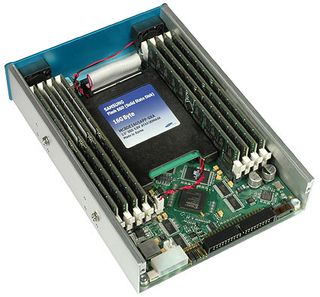HyperDrive 4 Redefines Solid State Storage
Inside The HyperDrive 4

The inside has changed a bit: the DIMM sockets have been moved to the sides, making room for an optional 2.5" UltraATA drive that is used as a permanent backup device in case of a power failure. The device automatically backs up the data onto an attached hard drive or Flash SSD, and it automatically starts restoring the data into the memory once power is restored. However, you should pay close attention to using a storage device that holds at least as much data as the memory, because the 16 GB Samsung Flash SSD we used had a net capacity of only 15.5 GB. Since our memory capacity was 16 GB, the total capacity was reduced to 15.5 GB.
We were able to mix memory modules of different capacities, but only as long as the same capacities were used within one bank. Each side inside the device represents a memory bank. We mixed four 512 MB DIMMs with four 1 GB DIMMs, which did not have an impact on performance, as there is no multi-channel operation. The good thing is that any ECC DDR1 memory can be used (DDR200, DDR333 or DDR400).
HyperOS states that the HyperDrive 4 requires 12 to 14 W, which is exactly what we measured (14.2 W max).


HyperDrive4 Performance Comparison

Source: HyperOS.
Due to time constraints, we haven't verified all the statements that HyperOS makes in this table, and the results do vary between different systems, but we tried some of them during the testing. Please take the numbers as an indicator rather than given facts, as they're from the manufacturer. I decided to include this table simply because it provides a very good overview of what a RAM-based solid state hard drive can do outside of what we can explain by our standard benchmarks. Simply put, it cuts down latencies to a fraction of what we're used to; this is nothing that a Flash drive has been capable of.
Stay on the Cutting Edge
Join the experts who read Tom's Hardware for the inside track on enthusiast PC tech news — and have for over 25 years. We'll send breaking news and in-depth reviews of CPUs, GPUs, AI, maker hardware and more straight to your inbox.
Current page: Inside The HyperDrive 4
Prev Page The HyperDrive 4 By HyperOS / Accelerated Logic Next Page Solid State Drive Comparison Table